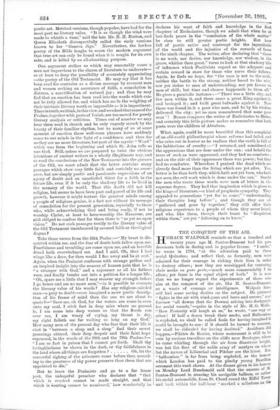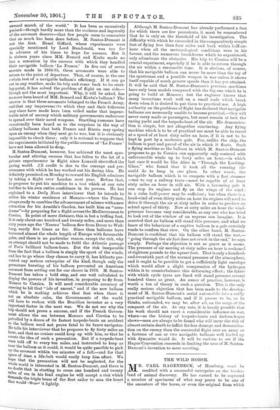THE CONQUEST OF THE AIR.
HORACE WALPOLE reminds us that a hundred and twenty years ago M. Santos-Dumont had his pre- decessors both in daring and in popular favour. "I smile,- he wrote in 1784, "at the adoration paid to these
aerial Quixotes ; and reflect that, as formerly, men were admired for their courage in risking their lives in order
to destroy others ; now they are worshipped for venturing their necks en pure perte,—much more commendably I do allow; yet fame is the equal object of both." It is true that we no longer regard the experiments of those who aim at the conquest of the air, like M. Santos-Dumont, as a waste of courage or intelligence. Walpole him- self had some saving doubts on the subject. He pictured " fights in the air with wind-guns and bows and arrows," and foresaw "all downs (but the Downs) arising into dockyards for aerial vessels,"—quite in the style of Mr. H. G. Wells. "How Posterity will laugh at us," he wrote, "one way. or other ! If half a dozen break their necks, and Balloonism is exploded, we shall be called fools for having imagined it could be brought to use: if it should be turned to account, we shall be ridiculed for having doubted." Accidents did happen,—Pililtre de Rozier, whose monument is still to be seen by curious travellers on the cliffs near Boulogne, where he came whirling through the air from disastrous height, was but the first of the noble army of martyrs on whose list the names of Lilienthal and Pitcher are the latest. Bat " balloonism " is far from being exploded, as the honour which London has paid to the plucky young Brazilian aeronaut this week shows. At the dinner given in his honour on Monday Lord Dundonald said that the success of Santos-Dumont in steering his navigable balloon, or rather his aerial automobile, from St. Cloud round the Eiffel Tower and back within the half-hour "marked a milestone on the onward march of the world." It has been so excessively psaieed--though hardly more than the coolness and ingenuity of the aeronaut deserve—that few people seem to remember that as much has been done before. M. Santos-Dumont is not the first. Henri Giffard, whose experiments were specially mentioned by Lord Dundonald, was too far in advance of his times to hope for success. But it is sixteen years since MM. Renard and Krebs made no less a sensation by the success with which they handled their navigable balloon La France.' In five out of seven ascents made in 1884-85, these aeronauts were able to return to the point of departure. That, of course, is the one certain test of a navigable balloon's efficiency. If it can go out in any weather, make its trip and come back to its start- ing-point, it has solved the problem of flight on one side,— though not the most important. Why, it will be asked, has no more been heard of MM. Renard and Krebs's balloon ? The answer is that these aeronauts belonged to the French Army, sad that any improvements which they and their followers may since have made have been veiled under that impene- trable mist of secrecy which military governments endeavour to spread over their novel weapons. Startling rumours have occasionally been heard as to the surprises in the way of military balloons that both France and Russia may spring upon an enemy when they next go to war, but it is obviously impossible to check these; only it is rational to suppose that the experiments initiated by the public success of La France ' have not been allowed to drop.
H. Santos-Dumont, however, has achieved the most spec- tacular and stirring success that has fallen to the lot of a private experimenter in flight since Lunardi electrified the gazing world. All credit is due to the courage and per- severance with which he has worked out his daring idea. He definitely promised on Monday to reward his English admirers by taking a flight over London next year. Before that, he proposes to put his machine to a test which at any rate testifies to his own entire confidence in its powers. He has explained to a Daily News interviewer that he intends to utilise his winter residence at Monaco—where the Prince, always ready to combine the advancement of science with anew attraction for his Armida's Garden, has built him an " aero- drome"—by preparing for a flight across the Mediterranean to Corsica. In point of mere distance, this is but a trifling feat. It is only about one hundred and twenty miles, and more than sixty years ago the Nassau' balloon flew from Dover to Weil- burg, nearly five times as far. Since then balloons have traversed almost the whole length of Europe with favourable gales, and there is no particular reason, except the risk, why an attempt should not be made to fulfil the Atlantic passage of Poe's brilliant balloon-hoax. But the risk inseparable from the fact that a balloon is simply the sport of the winds, and has to go where they choose to carry it, has hitherto pre- vented any serious enterprise of the kind, though only the premature bursting of his balloon prevented an American aeronaut from setting out for our shores in 1873. M. Santos- Dumont has taken a bold step, and one well calculated to display the powers of his invention, in proposing to fly from Monaco to Corsica. It will need considerable accuracy of steering to hit that "isle of unrest," and if the new balloon which he is making achieves that feat when there is not an absolute calm, the Governments of the world will have to reckon with the Brazilian inventor as a very
important factor in the next war. We do not see why the trip should not prove a success, and if the French Govern- ment allows the sea between Monaco and Corsica to be patrolled by a dozen of its fastest torpedo-boats an accident to the balloon need not prove fatal to its brave navigator. Re tells his interviewer that he proposes to fly forty miles an hour, and that no cruiser could keep up with him, so that he scouts the idea of such a precaution. But if a torpedo-boat
were told off to every ten miles, and instructed to keep as
near the balloon as it could, it would be quite possible to pick up the aeronaut within ten minutes of a fall,—and for that space of Aim a life-belt would easily keep him afloat. We
hope that the precaution will not be neglected, for the whole world is interested in M. Santos-Dumont, and there is no doubt that in starting to cross one hundred and twenty Miles of sea in his frail engine he will accept a risk 'which demands the triple brass of the first sailor to arm the heart that wou1d .-ffroe+ it lightly.
Although M. Santos-Dumont has already performed a feat for which there are few precedents, it must be remembered that he is only on the threshold of his investigation. The difficulty with which he succeeded in the comparatively simple feat of flying less than four miles and back within half-an- hour when all the meteorological conditions were in his favour, and the numerous breakdowns which he experienced, only adumbrate the obstacles. His trip to Corsica will be a crucial experiment, especially if he is able to return through the air within a reasonable time. It is obvious, of course, that his navigable balloon can never be more than the toy of the sportsman and a possible weapon in war unless it shows itself capable of much greater speeds than it has yet attained. It will be said that M. Santos-Dumont's previous machines have only been models compared with the big one which he is going to build at Monaco ; but the engineer knows that many inventions work well on a small scale which break down when it is desired to put them to practical use. A high authority on the problems of flight has declared that navigable balloons are necessarily unable to become practical,—they will never carry mails or passengers, but must remain at best the racing yacht and the torpedo-boat of the air. His demonstra- tion is simple, but not altogether convincing. Any flying machine which is to be of practical use must be able to travel at a speed of at least sixty miles an hour, if it is not to be kept in port by a moderate gale. For, unlike the ship, the balloon is part and parcel of the air in which it floats. Such a flying machine as the balloon in which M. Santos-Dumont proposes to go to Corsica can apparently only contend with unfavourable winds up to forty miles an hour,—in which last case it would be like Alice in "Through the Looking- Glass," who found that it took all the running she could do to keep in one place. In other words, the navigable balloon which is to compete with a fast steamer not to say a railway train—must be capable of at least sixty miles an hour in still air. With a favouring gale it can stop its engines and fly on the wings of the wind in a calm half-power may be sufficient; but when there is a head-wind of even thirty miles an hour its engines will need to drive it through the air at sixty miles in order to produce an actual speed of thirty. Now at sixty miles an hour the wind- - pressure becomes very considerable, as any one who has tried to look out of the window of an express can imagine. It is asserted that no balloon will stand this pressure, and what we blow of the behaviour of a captive balloon in a gale certainly tends to confirm that view. On the other hand, M. Santos- Dumont is confident that his balloon will stand the test,— "going through the air fast does not crush in the end," he says simply. Perhaps the objection is not so grave as it seems. The pressure of air moving at sixty miles an hour is reckoned at eighteen pounds to the square foot. That is only a hundred- and-twentieth part of the normal pressure of the atmosphere, and it ought to be possible to get a sufficiently light envelope which would allow a slight compression of the hydrogen within it to counterbalance this deforming effect ; the fabric with which cycle tyres are lined will stand pressure several hundred times as great. An ounce of practice, however, is worth a ton of theory in such a question. This is the only really serious objection that has been made to the develop- ment of M. Santos-Dumont's aerial automobile into a really practical navigable balloon, and if it proves to be, as he thinks, unfounded, we may be, after all, on the verge of the conquest of the air. At any rate, it is hardly possible that his work should not exert a considerable influence on war, where—as the history of torpedo-boats and forlorn-hopes shows—men are always to be found who will incur the risk of almost certain death to inflict far less damage and demoralisa- tion on the enemy than the successful flight over an army or a fortress of one or two navigable balloons well loaded up with dynamite would do. It will be curious to see if the Hague Convention succeeds in limiting the uses of M. Santos- Dumont's invention to mere scouting.















































 Previous page
Previous page